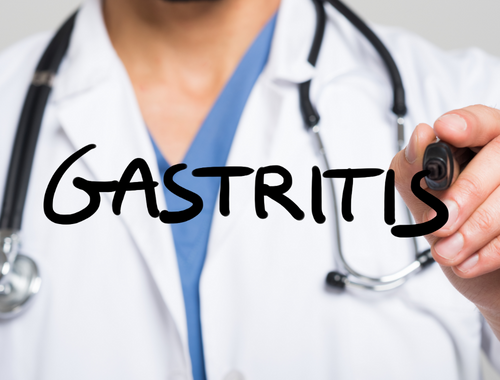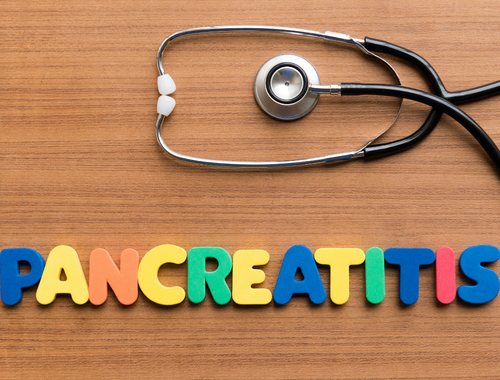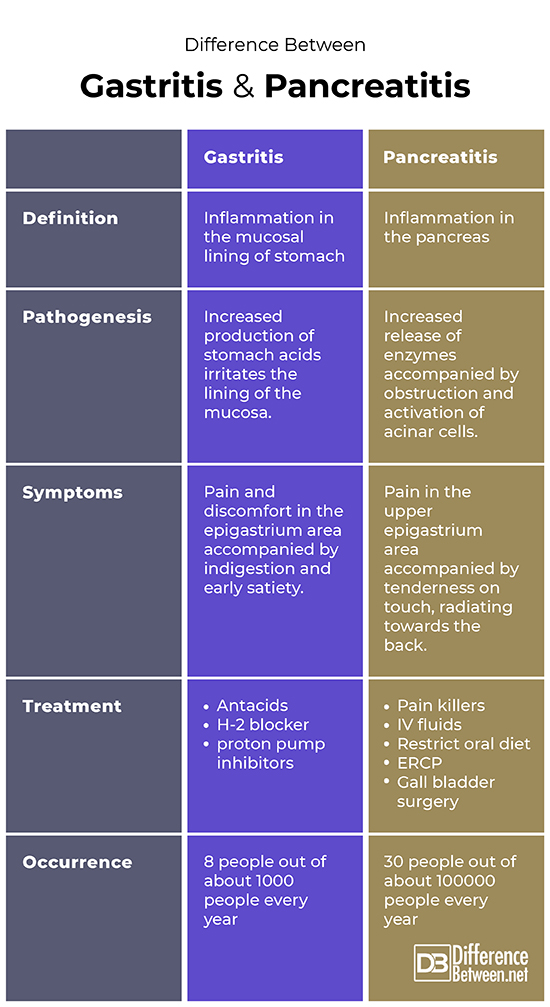The Difference Between Gastritis and Pancreatitis
Inflammation of the stomach lining is known as gastritis, while pancreatitis is when Pancreas is inflamed due to any trigger factor or condition. Both are inflammatory conditions and are responses to external stimuli.

What is Gastritis?
Introduction
When the lining of the stomach is irritated, eroded, or inflamed due to an external trigger factor, it is known as gastritis. Gastritis can be of two types: acute, which causes sudden and intense pain, and chronic, which causes symptoms for a long time and increases gradually.
Pathophysiology
Stomach is lined internally by a mucosal wall that releases gastric juices to aid in digestion. Sometimes, the conditions like unhealthy eating habits, alcohol, NSAIDs, or other conditions contribute to excess acid production which leads to damage in the mucosal wall, causing Gastritis.
Symptoms
It can either be asymptomatic or different individuals present with different symptoms. Some of the common symptoms are:
- Nausea accompanied by upset stomach
- Constant bloating
- Unable to digest food properly
- Pain in epigastrium
- Episodes of vomiting
- Heartburn
- Significant decrease in appetite
- Stools can be black/tarry in color
Causes
The few common causes of gastritis are:
- Acid reflux due to conditions like GERD (Gastrointestinal regurgitation disease)
- Alcohol abuse
- Some medications like NSAIDs (Non-steroidal Anti-inflammatory Drugs)
- Taking too much stress
- A bacterium called Helicobacter Pylori.
Diagnosis
- Upper GIT endoscopy
- Blood test
- Biopsy
- Stool test
- H. Pylori breath test
Prevention and Treatment
A healthy lifestyle is key to preventing gastritis and other GIT-related illnesses.
Treatment options are:
- Medications like antacids, proton pump inhibitors, and H2 blockers can be used to minimize the production of gastric acids.
- Reducing stress levels through a healthy lifestyle, stress-releasing maneuvers, and taking antianxiety medications.
- Reducing the intake of spicy food.
- Limiting dairy if lactose intolerance is the underlying cause
- Antibiotics therapy if H. Pylori is detected.

What is Pancreatitis?
Introduction
Inflammation or swelling of the pancreas is referred to as pancreatitis.
Pancreas is a flat, leaf-shaped gland located within the GIT tract. It is responsible for producing:
- A hormone insulin
- pancreatic enzymes that aid in digestion.
Pathophysiology
Overstimulation of the pancreas leads to the obstruction of the pancreatic duct. It leads to an increase in the release of pancreatic enzymes, which results in increased trypsin reflux. Increased trypsin activation within acinar cells of the pancreas leads to pancreatitis.
Symptoms
Acute and chronic pancreatitis differs in presentation but there are symptoms common to both of the conditions.
- Pain in epigastrium
- Abdomen is tender to touch
- Pain and tenderness radiates towards back
- Nausea that can be accompanied by vomiting
- Increased heart rate
- Fever
Causes
It can be caused by:
- Stones in the bile duct, causing obstruction
- Alcohol abuse
- Increased levels of triglycerides
- Hyperparathyroidism that results in high calcium levels
- Medications like steroids, etc.
- Viral and bacterial infections
- Autoimmune conditions like cystic fibrosis
- Traumatic injury to pancreas
Treatment
- Hospitalization
- Limiting oral intake of food
- IV fluids
- IV antibiotics (if an infection is a case)
- Painkillers
- ERCP (endoscopic retrograde cholangiopancreatography)
- Gall stones surgery to remove gall bladder
Prevention
- Avoid alcohol and cigarette smoking
- High protein, low-fat meals
- Gall bladder surgery if gall stones are trigger factor.
Difference between Gastritis and Pancreatitis

Summary of Difference between Gastritis and Pancreatitis
- Gastritis is inflammation or erosion of the mucosal lining of the stomach while pancreatitis is inflammation of the pancreas.
- Gastritis is characterized by heartburn, indigestion, and pain in the epigastrium; whereas pancreatitis is presented by epigastrium pain that radiates toward the back, the area around the epigastrium is tender to touch, and fever.
- Gastritis is more common and occurs in every 8 people out of 1000. Pancreatitis is less common, its frequency is 30 people out of almost 100000.
- Treatment of gastritis involves medications like Antacids, 2 inhibitors, and proton pump inhibitors. Pancreatitis is either treated symptomatically with pain relief and IV fluids or surgeries like ERCP and Gall bladder surgery to remove gall stones.
- Gastritis is caused by consuming excessively hot and spicy food, or excessive production of gastric juices because of conditions like GERD, etc. pancreatitis is caused either by infections or obstruction in the bile duct due to gallstones.
FAQs
Are pancreatitis and gastritis related?
Pancreatitis and Gastritis both are common diseases of the Digestive tract and are caused by any infection or inflammation.
What can be misunderstood for pancreatitis?
Pancreatic cancer and pancreatitis share the same signs and symptoms. Pancreatitis can be mistaken for several other conditions like gall stones, peptic ulcer, and biliary colic.
What part of your stomach hurts with pancreatitis?
The upper part of the abdomen hurts with pancreatitis. The pain radiates toward the back and the area of the epigastrium is tender to touch.
What is the number one symptom of pancreatitis?
The number one symptom of inflammatory pancreatitis is severe pain, usually in the upper part of the stomach that radiates toward the back and chest.
What are the two 2 most common causes of pancreatitis?
The two most common causes of pancreatitis are:
- Excessive Alcohol consumption
- Gall bladder stones that obstruct the bile duct
- Difference Between Cystocele and Rectocele - September 8, 2023
- Comparison Between DHEA and DHEA Sulfate - September 1, 2023
- Difference Between Osteoporosis and Osteopenia - June 14, 2023
Search DifferenceBetween.net :
Leave a Response
References :
[0]Gastroenterology. (n.d.). A case of acute hypertrophic gastritis with pancreatitis: Official Journal of the American College of Gastroenterology: ACG. LWW. Retrieved February 23, 2023, from https://journals.lww.com/ajg/Fulltext/2014/10002/A_Case_of_Acute_Hypertrophic_Gastritis_With.142.aspx
[1]Jeffrey C F Tang, M. D. (2022, July 13). Acute pancreatitis. Practice Essentials, Background, Pathophysiology. Retrieved February 23, 2023, from https://emedicine.medscape.com/article/181364-overview
[2]Wirth, H.-P., & Yang, M. (2016, October). Different pathophysiology of gastritis in East and West? A Western perspective. Inflammatory intestinal diseases. Retrieved February 23, 2023, from https://www.ncbi.nlm.nih.gov/pmc/articles/PMC5988118/#:~:text=Gastritis%20denotes%20(cellular)%20inflammation%20due,%2C%20alcohol%2C%20chemicals%20and%20radiation.
